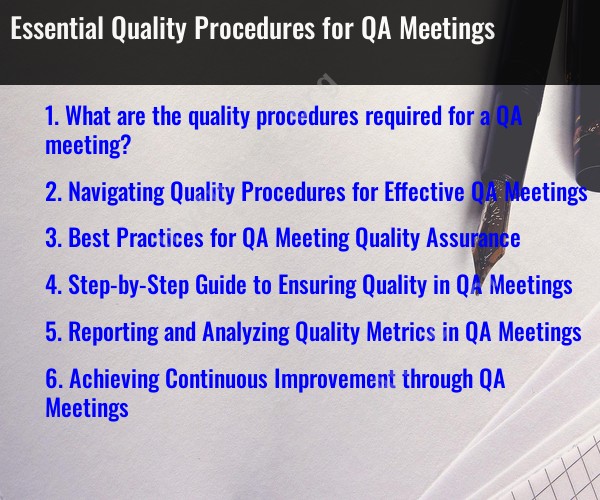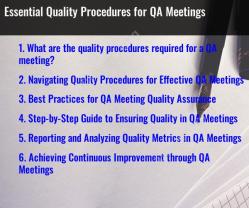What are the quality procedures required for a QA meeting?
Quality Assurance (QA) meetings play a critical role in ensuring the quality of products, services, and processes within an organization. Here are some essential quality procedures that should be considered for QA meetings:
Agenda Preparation:
- Define a clear agenda that outlines the topics to be discussed during the meeting.
- Include objectives and expected outcomes for each agenda item.
Meeting Scheduling:
- Set a regular schedule for QA meetings, such as weekly, bi-weekly, or monthly.
- Ensure the meeting duration is appropriate to cover all agenda items without rushing.
Meeting Facilitation:
- Designate a skilled meeting facilitator to lead the meeting and keep discussions focused.
- Encourage active participation from all attendees.
Attendance and Participation:
- Ensure that all relevant team members and stakeholders are invited and encouraged to attend.
- Promote an environment where team members feel comfortable sharing their insights and concerns.
Documentation and Record-Keeping:
- Assign someone to take meeting minutes or notes to document discussions, decisions, action items, and responsible parties.
- Archive meeting minutes for future reference and audits.
Review of QA Procedures:
- Regularly review and update QA procedures to ensure they align with current industry standards and best practices.
Quality Metrics and Key Performance Indicators (KPIs):
- Discuss and analyze relevant quality metrics and KPIs to assess the performance and effectiveness of QA processes.
- Identify trends, issues, or areas for improvement based on these metrics.
Issue Identification and Resolution:
- Allocate time for identifying and discussing quality issues, defects, and non-conformities.
- Establish action plans to address identified problems and track their resolution.
Risk Assessment:
- Evaluate potential risks that could impact product quality or project timelines.
- Develop risk mitigation strategies and contingency plans.
Continuous Improvement:
- Allocate time to discuss opportunities for process improvement and efficiency gains.
- Encourage team members to share suggestions for enhancing QA practices.
Training and Skill Development:
- Address training needs and skill development requirements for QA team members.
- Discuss strategies for maintaining a skilled and up-to-date QA workforce.
Feedback Collection and Analysis:
- Solicit feedback from team members and stakeholders on the effectiveness of QA processes.
- Analyze feedback to identify areas for improvement.
Compliance and Standards:
- Ensure that QA procedures and processes align with industry standards and regulatory requirements.
- Discuss any changes in standards and compliance requirements that may affect QA.
Action Item Tracking:
- Keep track of action items assigned during the meeting, including deadlines and responsible parties.
- Review the status of previous action items in subsequent meetings.
Documentation of Decisions:
- Clearly document decisions made during the meeting, including the rationale behind them.
- Ensure that action items arising from decisions are well-defined.
Communication of Outcomes:
- Share the outcomes of the QA meeting with relevant stakeholders and team members.
- Ensure that everyone is aware of the decisions, action items, and responsibilities assigned.
Follow-Up:
- Schedule follow-up meetings to track the progress of action items and address any outstanding issues.
Quality procedures for QA meetings should be tailored to the specific needs and requirements of your organization, industry, and projects. Regularly reviewing and adapting these procedures is essential to maintain and enhance the quality of products and services.
Navigating Quality Procedures for Effective QA Meetings
Quality assurance (QA) meetings are an essential part of the software development process. They provide a forum for QA engineers to discuss the quality of a product, identify and prioritize issues, and track progress towards resolution.
To ensure that QA meetings are effective, it is important to have a clear understanding of the quality procedures that should be followed. These procedures should be documented and communicated to all members of the QA team.
Here are some key quality procedures for effective QA meetings:
- Prepare for the meeting. This includes reviewing the agenda, gathering any relevant materials, and coming to the meeting prepared to discuss the topics at hand.
- Be on time and start the meeting promptly. This shows respect for everyone's time and helps to keep the meeting on track.
- Follow the agenda. This helps to ensure that the meeting stays focused and that all important topics are discussed.
- Encourage participation from all members of the team. This helps to ensure that all perspectives are heard and that everyone has a chance to contribute.
- Take notes and document the meeting. This helps to ensure that there is a record of what was discussed and that any action items are clearly defined.
- Follow up on action items. This helps to ensure that the meeting is not just a talking shop and that progress is being made towards resolving issues.
Best Practices for QA Meeting Quality Assurance
In addition to following the quality procedures outlined above, there are a number of best practices that QA teams can follow to ensure the quality of their meetings. These best practices include:
- Set clear objectives for each meeting. What do you want to achieve by the end of the meeting? Make sure that everyone on the team is aware of the objectives and that the meeting is structured to achieve them.
- Keep meetings focused and on track. Avoid getting sidetracked by irrelevant topics or discussions. If a topic is not relevant to the meeting objectives, table it for discussion at a later time.
- Encourage open and honest communication. Create an environment where everyone feels comfortable sharing their ideas and concerns. This will help to ensure that all issues are identified and addressed.
- Make decisions and assign action items. Don't leave the meeting without making some progress towards resolving issues. Assign action items to specific individuals with clear deadlines.
- Follow up after the meeting. Make sure that everyone on the team is aware of the action items and that they are working towards completing them.
Step-by-Step Guide to Ensuring Quality in QA Meetings
Here is a step-by-step guide to ensuring the quality of QA meetings:
- Plan the meeting. Determine the purpose of the meeting, identify the key topics that need to be discussed, and create an agenda.
- Prepare for the meeting. Gather any relevant materials, such as test reports, bug reports, and product documentation.
- Start the meeting on time. Review the agenda and make sure that everyone is aware of the purpose of the meeting.
- Discuss the key topics. Encourage participation from all members of the team and be sure to document the discussion.
- Make decisions and assign action items. Don't leave the meeting without making some progress towards resolving issues.
- End the meeting on time. Review the action items and make sure that everyone is aware of their responsibilities.
- Follow up after the meeting. Make sure that everyone on the team is working towards completing their action items.
Reporting and Analyzing Quality Metrics in QA Meetings
QA meetings are a great opportunity to report and analyze quality metrics. This information can be used to identify areas where the team is doing well and areas where improvement is needed.
Some common quality metrics that are reported and analyzed in QA meetings include:
- Number of bugs found and fixed
- Time to resolve bugs
- Customer satisfaction with the product
- Test coverage
- Defect density
By reporting and analyzing quality metrics in QA meetings, teams can identify trends and make informed decisions about how to improve the quality of their products.
Achieving Continuous Improvement through QA Meetings
QA meetings can be a powerful tool for achieving continuous improvement. By following the best practices outlined above, teams can ensure that their meetings are effective and that they are making progress towards improving the quality of their products.
Here are some specific ways that QA teams can use meetings to achieve continuous improvement:
- Use meetings to identify and prioritize areas for improvement. By discussing quality metrics and customer feedback, teams can identify the areas where they need to focus their efforts.
- Use meetings to develop and implement improvement plans. Once areas for improvement have been identified, teams can develop and implement plans to address them.
- **Use meetings to track progress and make


